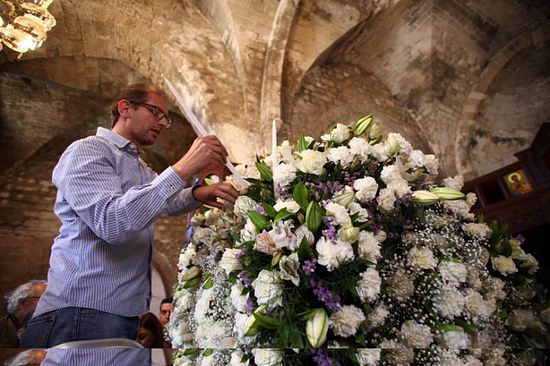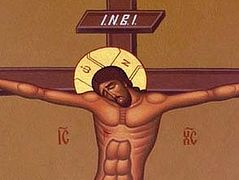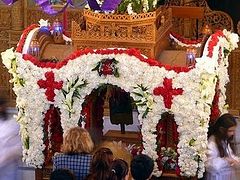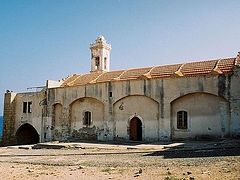By Constantinos Psillides
Famagusta, Cyprus, April 18, 2014
Thousands of Greek Cypriots, most refugees, flocked to the Ayios Giorgos Exorinos church in Famagusta where they attended a Good Friday service at their historical place of worship for the first time in decades.
The service, the first since 1957 at the church in the medieval town, should send a message of hope and reunification, said leaders of both major parties AKEL and DISY on their way to the thronged church and its courtyard.
More than 4,000 people attended the service that started at around 5pm and was set to run for three and a half hours.
The organisers said that around 3,000 people reserved a bus seat but a lot of people just travelled there by car. The church was visited not only by Famagustians but also by other refugees as well as people who just wanted to witness the historic event including foreign ambassadors.
Volunteers began arriving at the church from 5.30am to decorate the ‘Epitaphios’, which symbolises the body of Christ in Orthodox tradition.
The service was broadcast live on all TV channels and by some foreign media.
Many of those attending the service were too emotional too speak to the television cameras but those who did, sent a message of hope and reconciliation.
“I cannot describe how I feel. I’m overwhelmed with emotion for having the privilege to be here, attend the Good Friday service in this church”, said one woman who said she was a refugee from Famagusta.
“I think that a solution must be found. Greek Cypriots and Turkish Cypriots can live together and our churches are longing for their bells to be tolled and for services to be held within their walls,” she said.
Another refugee, Zeta Stavrinou was similarly overwhelmed. “I’m so emotional I don’t think I can take it anymore. I never believed that in my lifetime I would ever see a service in this church again. My parents got married in this church and we used to live around this part of the town when I was a kid,” she said, adding that she was sorry that a lot of her relatives didn’t get to see the church again. “I would like to thank everyone that made this a reality. Thank you. Thank you”.
But it wasn’t just people living in Cyprus that attended the event. Vasilis Mavrou, a refugee from Famagusta travel from England where he now lives. “I come to Cyprus every year for the Easter holidays and this year I came specifically to attend this event. I’m thrilled to be here, it’s the second time I’m visiting Famagusta. I hope that the refugees from Famagusta return to their homes. Today’s message should be that Greek Cypriots and Turkish Cypriots should stick together so we can build a new Cyprus,” he said.
Leader of ruling party DISY Averof Neophytou also attended the event. Neophytou said that the service is a message of reconciliation and a path to trust between Greek Cypriots and Turkish Cypriots “the path that will lead us to salvation and to the resurrection of Cyprus, so we can see our country reunited once more,” he said.
“The road ahead is very difficult and steep, much like the road to Calvary. We have to trek it though, or else we will never reach the Resurrection,” Neophytou added.
The DISY leader admitted that it was his first time in Famagusta, despite being 53 years old. “Forty years ago, when the invasion took place, I was just a kid. Forty years of occupation is too many. If our generation didn’t get to see the whole country, one can only imagine what that means for our kids, teenagers and my three-year-old child. We must work hard. We must reunite our country,” he said.
Neophytou was joined by the leader of AKEL, the main opposition party, Andros Kyprianou. Kyprianou said that he was deeply moved to have come to the church and that the service should send the message that 40 years of occupation was too much. “Greek Cypriots and Turkish Cypriots must work together to unite the island. This is the message we are sending by attending the Good Friday service. I’d like to believe that our message is being heard in every corner of the island,” Kyprianou said.
The church lies within the walled city of Famagusta, which is at very close proximity to the fenced off area of Famagusta, known as Varosha. Diplomatic initiatives are currently underway to have Varosha returned to Greek Cypriots as a confidence building measure. Several ambassadors attended the event as did the Turkish Cypriot Mufti , Dr Talip Atalay. The Bishop of Constantia and Famagusta, Vasileios, who officiated the service, presented the Turkish Cypriot religious leader with a copy of a lead seal, first commissioned by one of his predecessors bishop Akakios who lived in the 7th Century AD.
Both clerics spoke of the peace that could be accomplished through religion, saying the Famagusta service was a testament to that.




